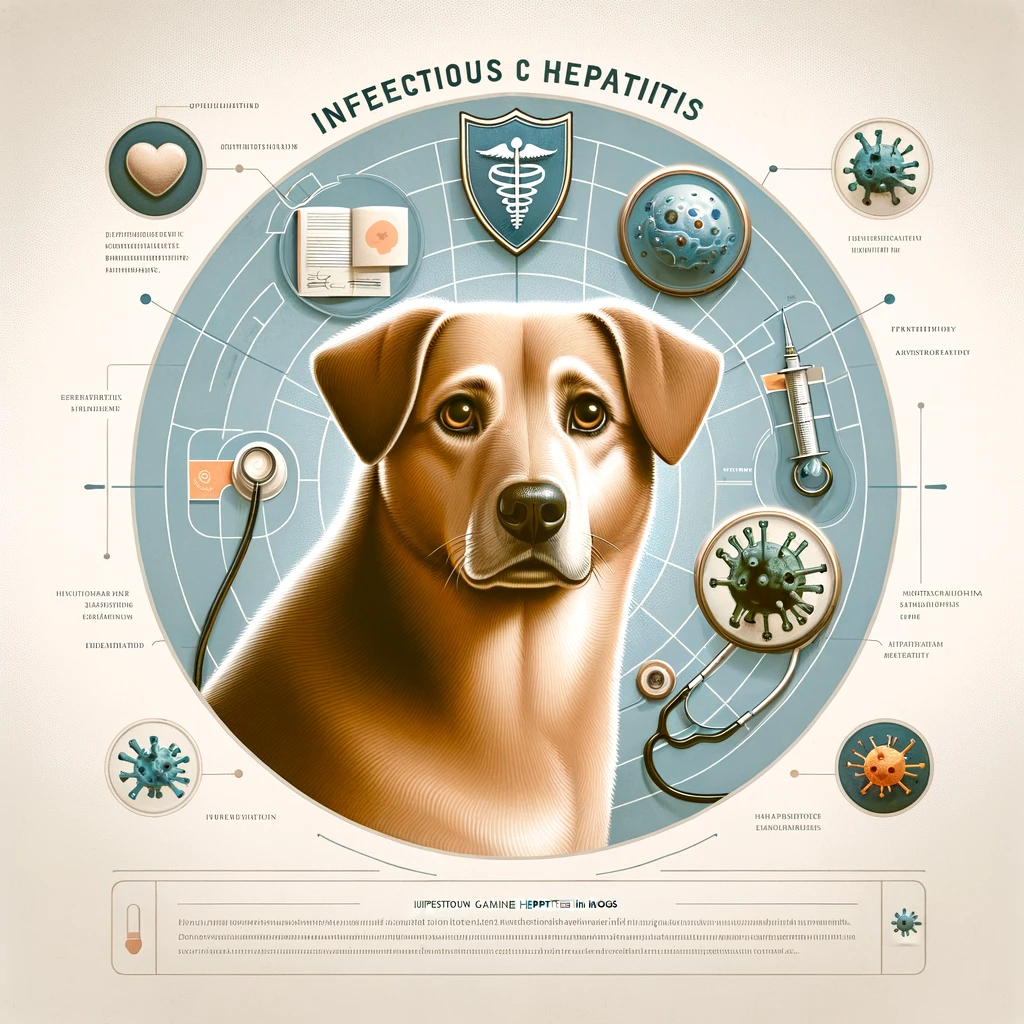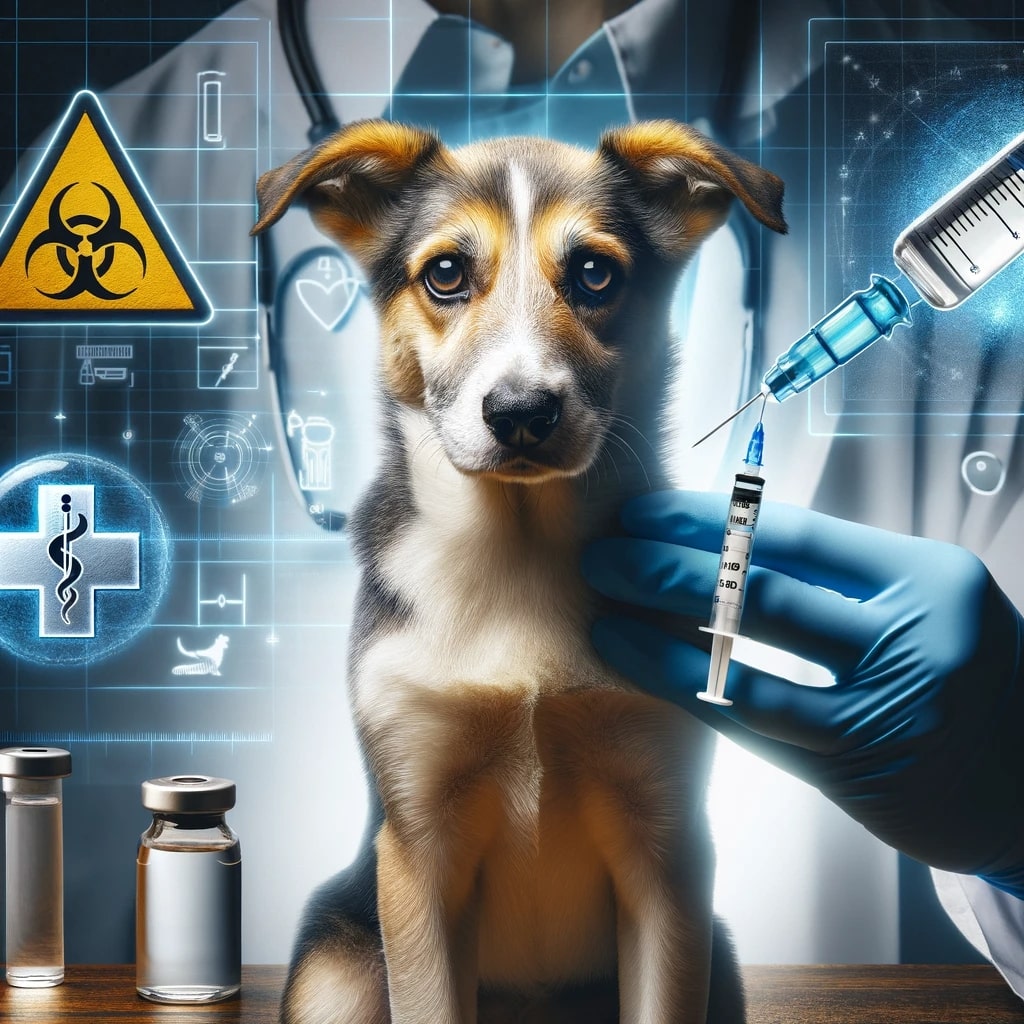Infectious Canine Hepatitis (ICH) is a significant health concern for dog owners worldwide. This article aims to address the most commonly asked questions about ICH, providing in-depth information to help you understand, prevent, and manage this disease in your furry friends.
What is Infectious Canine Hepatitis?
Infectious Canine Hepatitis (ICH) is a highly contagious viral disease affecting dogs. It is caused by Canine Adenovirus Type 1 (CAV-1), which primarily targets the liver, kidneys, spleen, and lungs. ICH can range from a mild illness to a severe, life-threatening condition.
The Etiology of ICH
ICH is caused by the Canine Adenovirus Type 1. This virus is highly contagious and can be transmitted through direct contact with infected bodily fluids, including saliva, urine, and feces. The virus can also be spread through contaminated objects like food bowls, bedding, and toys.
Clinical Signs
Dogs infected with ICH may show various symptoms, ranging from mild to severe. Common signs include:
- Fever
- Lethargy
- Loss of appetite
- Abdominal pain
- Vomiting and diarrhea
- Jaundice (yellowing of the skin and eyes)
- Cloudy or blue-tinted eyes (corneal edema)
Diagnosis
Veterinarians diagnose ICH based on clinical signs, history of exposure, and diagnostic tests. These tests may include:
- Blood tests (Complete Blood Count, Liver Enzymes)
- Urinalysis
- Imaging studies (X-rays, ultrasound)
- Specific tests for Canine Adenovirus
Treatment Options
There is no specific treatment for the virus itself, but supportive care is crucial. This may include:
- Intravenous fluids to maintain hydration
- Nutritional support
- Medications to control vomiting and diarrhea
- Antibiotics to prevent secondary bacterial infections
Prognosis
The prognosis for dogs with ICH varies. Early diagnosis and aggressive supportive care can improve the chances of recovery. However, severe cases, especially in young puppies, can be fatal.
Prevention Strategies
Prevention is key in managing ICH. Key strategies include:
- Vaccination against Canine Adenovirus
- Good hygiene and sanitation practices
- Isolating infected dogs to prevent the spread of the virus
Understanding the Vaccine
The ICH vaccine is highly effective and is usually part of the standard vaccination protocol for dogs. It specifically targets Canine Adenovirus Type 2, which provides cross-protection against CAV-1.
Long-term Health Implications
Dogs that recover from ICH may have long-term health issues, particularly related to liver function. Regular veterinary check-ups and supportive care are essential for these dogs.
Conclusion
Infectious Canine Hepatitis is a serious disease, but with proper prevention and prompt medical care, dogs can lead healthy lives. Understanding the nature of this disease is crucial for responsible dog ownership.
How is Infectious Canine Hepatitis Transmitted?
The transmission of Infectious Canine Hepatitis (ICH) is a critical aspect of understanding and preventing this disease. Knowing how it spreads can help dog owners take proactive steps to protect their pets.
Direct Contact Transmission
ICH is primarily spread through direct contact with infected bodily fluids. Dogs can contract the virus by:
- Sniffing or licking urine, feces, or saliva of an infected dog
- Direct contact with an infected dog
Indirect Transmission
The virus can also spread indirectly through:
- Contaminated objects like bowls, toys, and bedding
- Human hands or clothing that have come into contact with the virus
Environmental Stability of the Virus
CAV-1, the virus causing ICH, is relatively stable in the environment. It can survive outside the host for weeks, making indirect transmission a significant concern.
Role of Wildlife in Transmission
Wild canids, such as foxes and wolves, can also carry and transmit CAV-1, posing a risk of spreading the virus to domestic dogs.
Vertical Transmission
While not common, there is a potential for pregnant dogs infected with CAV-1 to transmit the virus to their unborn puppies.
Airborne Transmission
Currently, there is no evidence to suggest that ICH is transmitted through the air. It primarily spreads through direct or indirect contact with infected fluids.
Human Transmission
Humans cannot contract ICH, but they can play a role in its transmission. Good hygiene practices are crucial for those handling infected dogs.
Waterborne Transmission
Contaminated water sources can be a potential transmission route, especially in areas with a high population of infected animals.
Asymptomatic Carriers
Some dogs may carry the virus without showing symptoms, acting as silent spreaders of the disease. These asymptomatic carriers are particularly challenging in controlling the spread of ICH.
Quarantine and Isolation
For dogs diagnosed with ICH, quarantine and isolation are essential to prevent further transmission. Infected dogs should be kept away from other dogs until they are no longer contagious.
Reducing Risk in Multi-Dog Households
In households with multiple dogs, extra precautions should be taken if one dog is diagnosed with ICH:
- Separate feeding and water bowls
- Disinfect shared spaces and items regularly
- Avoid close contact between the infected dog and other pets
Community Precautions
In communities with known cases of ICH, dog owners should:
- Avoid dog parks and communal areas
- Be vigilant about hygiene and sanitation
- Monitor their pets for any signs of illness
Conclusion
Understanding the transmission of Infectious Canine Hepatitis is vital in preventing its spread. Through proper hygiene, quarantine measures, and awareness, dog owners can play a significant role in protecting their pets and the wider canine community from this disease.
What Are the Early Signs and Symptoms of Infectious Canine Hepatitis?
Recognizing the early signs and symptoms of Infectious Canine Hepatitis (ICH) is crucial for prompt treatment and better prognosis. Here’s a detailed look at the initial indicators of ICH in dogs.
Fever and Lethargy
One of the first signs of ICH is a sudden spike in body temperature. Affected dogs may become lethargic and less responsive.
Loss of Appetite
Dogs with ICH often show a decreased interest in food. This symptom, combined with other signs, warrants veterinary attention.
Respiratory Symptoms
Some dogs may exhibit mild respiratory symptoms like coughing or nasal discharge in the early stages of the infection.
Gastrointestinal Distress
Vomiting and diarrhea are common in dogs suffering from ICH, which can lead to dehydration if not addressed promptly.
Pain and Discomfort
Dogs may show signs of abdominal pain, such as whining or reluctance to be touched around the stomach area.
Eye Changes
A notable symptom of ICH is the development of a cloudy or bluish hue in the eyes, known as corneal edema.
Behavioral Changes
Affected dogs may exhibit changes in behavior, such as increased irritability or depression, as a response to feeling unwell.
Bleeding Disorders
As the disease progresses, some dogs may develop bleeding disorders, evidenced by bruising or blood in urine and feces.
Early Detection is Key
Recognizing these early signs and seeking veterinary care is vital for the effective management of ICH.
Conclusion
Being vigilant about the health of your dog and noticing early signs of illness can significantly impact the outcome of infectious diseases like ICH. Regular check-ups and maintaining a close bond with your pet will help you detect any unusual changes in their health.
How Can Infectious Canine Hepatitis Be Prevented?
Preventing Infectious Canine Hepatitis (ICH) is vital for maintaining the health and wellbeing of your dog. Here are the key strategies to minimize the risk of your pet contracting this disease.
Vaccination
Vaccination is the most effective way to prevent ICH. The canine adenovirus vaccine, usually given as part of a combination vaccine, is highly effective.
- Puppy Vaccination Schedule: Puppies typically receive their first vaccine between 6 to 8 weeks of age, with boosters at 3-4 week intervals until they are about 16 weeks old.
- Adult Vaccination: Adult dogs should receive regular booster vaccinations as recommended by your veterinarian.
Isolation of Infected Dogs
If a dog is diagnosed with ICH, it should be isolated from other dogs to prevent the spread of the virus.
Good Hygiene Practices
Maintaining good hygiene is crucial in preventing the spread of ICH.
- Regular cleaning and disinfection of your dog’s living area and belongings.
- Washing your hands after handling any dog, especially if you’re in contact with multiple dogs.
Avoiding High-Risk Areas
Avoid taking your dog to places where an outbreak has been reported. This includes dog parks, kennels, and other communal areas where dogs gather.
Controlling Wildlife Exposure
Since wild animals can be carriers of the virus, try to minimize your dog’s interaction with wildlife.
Regular Health Check-Ups
Regular veterinary check-ups can help catch early signs of illness and ensure that your dog’s vaccinations are up to date.
Community Awareness
Being informed about the health status of other dogs in your community can help you take preventive measures in time.
Proper Nutrition and Care
A well-balanced diet and proper care boost your dog’s immune system, making them less susceptible to infections like ICH.
Conclusion
Prevention of Infectious Canine Hepatitis requires a combination of vaccination, good hygiene, and responsible pet ownership. By following these guidelines, you can significantly reduce the risk of your dog contracting this serious disease.
What is the Treatment for Infectious Canine Hepatitis?
Understanding the treatment options for Infectious Canine Hepatitis (ICH) is crucial for any dog owner. Here we explore the various methods used to manage this disease in affected dogs.
Supportive Care
Since there is no specific cure for the virus causing ICH, treatment mainly involves supportive care:
- Intravenous Fluids: To prevent dehydration and maintain electrolyte balance.
- Nutritional Support: Ensuring the dog receives adequate nutrition, possibly through a feeding tube in severe cases.
- Medications: To control symptoms like vomiting, diarrhea, and to reduce inflammation.
Managing Secondary Infections
Antibiotics may be prescribed to prevent or treat secondary bacterial infections, a common complication in viral illnesses like ICH.
Hospitalization
Severely affected dogs may need to be hospitalized for intensive care and monitoring, especially in cases of liver failure or severe bleeding disorders.
Pain Management
Pain relief medications may be administered to ensure the dog’s comfort during recovery.
Long-Term Management
Dogs recovering from ICH may require ongoing care, including:
- Regular veterinary check-ups.
- Liver function tests to monitor any long-term impacts on the liver.
- Adjustments in diet and lifestyle as recommended by the vet.
Home Care
After returning home, the dog will need:
- A quiet and comfortable space to recover.
- Close monitoring for any worsening of symptoms.
- Strict adherence to the veterinarian’s instructions regarding medication and care.
Vaccination Post-Recovery
Once recovered, dogs should be vaccinated against ICH as they may not develop lasting immunity from the infection.
Prognosis
The prognosis for dogs with ICH varies. Early detection and aggressive treatment can improve the outcome, but the disease can be fatal, especially in young puppies or dogs with pre-existing health conditions.
Conclusion
While Infectious Canine Hepatitis can be a severe disease, appropriate and timely treatment can greatly increase the chances of a full recovery. Regular veterinary care and attention to your dog’s overall health are key in managing this condition.
Can Infectious Canine Hepatitis Affect Other Animals or Humans?
A common concern among pet owners is whether diseases like Infectious Canine Hepatitis (ICH) can affect other animals or even humans. This section addresses these concerns and clarifies the nature of ICH’s infectivity.
Species Specificity of ICH
Infectious Canine Hepatitis is caused by Canine Adenovirus Type 1 (CAV-1), which is primarily specific to canines. This means:
- Dogs are the Main Hosts: ICH predominantly affects dogs and is a significant health concern for them.
- Limited Risk to Other Animals: While CAV-1 can occasionally infect other animals, such instances are rare and typically do not lead to serious illness.
Impact on Other Canine Species
Besides domestic dogs, other members of the canine family, such as foxes, wolves, and coyotes, can be susceptible to ICH.
Risk to Humans
There is no evidence that Infectious Canine Hepatitis can be transmitted to humans. CAV-1 does not pose a risk to human health.
Cross-Species Transmission Concerns
While the primary concern is within canine populations, it’s essential to:
- Monitor interactions between domestic dogs and wild canine species.
- Practice good hygiene, especially in multi-species households, although the risk is minimal.
Vaccination and Containment
Preventing the spread of ICH within canine populations through vaccination and containment is crucial for protecting both domestic and wild canine species.
Conclusion
Infectious Canine Hepatitis is a disease specific to dogs and poses no direct risk to humans or most other animal species. Understanding the species-specific nature of this virus helps in focusing preventive measures and alleviating concerns about cross-species transmission.
What Are the Long-Term Effects of Infectious Canine Hepatitis on a Dog’s Health?
Understanding the long-term effects of Infectious Canine Hepatitis (ICH) is crucial for dog owners who are managing or have managed a pet with this condition. Here we explore the potential lasting impacts of ICH on a dog’s health.
Chronic Liver Disease
One of the primary concerns following an ICH infection is the potential development of chronic liver disease, as the virus primarily affects the liver.
- Liver Function: Regular monitoring of liver enzymes and function is essential for dogs that have recovered from ICH.
- Diet and Management: A diet tailored for liver health may be recommended by your veterinarian.
Ocular Conditions
Dogs that have had ICH may suffer from eye conditions like ‘Blue Eye’ (corneal edema), which might persist or recur even after other symptoms have resolved.
Immune-Mediated Conditions
Some dogs may develop immune-mediated conditions post-ICH infection, requiring ongoing management and treatment.
Impact on Kidney Function
In addition to the liver, ICH can also affect kidney function, necessitating regular monitoring and possibly long-term management.
Behavioral Changes
Some dogs may exhibit long-term behavioral changes post-recovery, which could be linked to the illness’s impact on their overall health and wellbeing.
Decreased Stamina and Energy
Recovered dogs might display decreased stamina and energy levels, requiring adjustments in exercise and daily routines.
Regular Health Check-Ups
Regular veterinary check-ups are crucial for monitoring the long-term health of a dog that has survived ICH.
Vaccination Considerations
Post-recovery, it’s essential to discuss with your vet the future vaccination schedule, especially concerning adenovirus vaccines.
Quality of Life
With proper management, most dogs can continue to have a good quality of life after recovering from ICH.
Conclusion
While Infectious Canine Hepatitis can have lasting effects, with vigilant care and regular veterinary support, many dogs go on to live full and happy lives post-recovery.
How is Infectious Canine Hepatitis Diagnosed?
Accurate diagnosis of Infectious Canine Hepatitis (ICH) is crucial for effective treatment and management. This section explores the diagnostic methods used by veterinarians to confirm ICH in dogs.
Clinical Examination
The first step in diagnosing ICH is a thorough clinical examination by a veterinarian. This includes:
- Assessing Symptoms: Evaluating the dog for common signs like fever, lethargy, abdominal pain, and eye changes.
- Medical History: Discussing the dog’s medical history, vaccination status, and potential exposure to infected animals.
Blood Tests
Blood tests are essential for diagnosing ICH and may include:
- Complete Blood Count (CBC): To check for signs of infection or anemia.
- Liver Function Tests: Elevated liver enzymes can indicate liver damage, a common effect of ICH.
- Coagulation Profile: To assess the blood’s ability to clot, as ICH can cause bleeding disorders.
Urinalysis
Urinalysis can help assess kidney function and detect the presence of the virus or its effects on the urinary system.
Virus Detection
Specific tests to detect the Canine Adenovirus Type 1 include:
- PCR (Polymerase Chain Reaction): A sensitive test to detect the presence of viral DNA in blood or tissue samples.
- Virus Isolation: Growing the virus from samples in a lab, though less commonly used due to complexity.
Imaging Studies
X-rays or ultrasound may be used to assess the extent of organ involvement, particularly liver and kidney changes.
Biopsy
In some cases, a liver biopsy may be performed to assess the extent of liver damage and confirm the diagnosis.
Differential Diagnosis
Veterinarians will also consider other diseases that present with similar symptoms, such as leptospirosis or liver disease from other causes.
Conclusion
Diagnosing Infectious Canine Hepatitis involves a combination of clinical evaluation, laboratory tests, and sometimes imaging studies. Early and accurate diagnosis is key to managing the disease effectively and improving the prognosis for the affected dog.
What Are the Risk Factors for Infectious Canine Hepatitis?
Identifying and understanding the risk factors for Infectious Canine Hepatitis (ICH) is important for preventing this disease in dogs. Here we discuss the various factors that can increase a dog’s susceptibility to ICH.
Age
Young puppies and elderly dogs are more susceptible due to their less robust immune systems.
- Puppies: They may not have full immunity, especially if they haven’t completed their vaccination series.
- Elderly Dogs: Older dogs may have a weakened immune system, making them more vulnerable.
Vaccination Status
Unvaccinated dogs are at a significantly higher risk of contracting ICH.
- Incomplete Vaccination: Dogs that have not received all their vaccination shots are more prone to ICH.
- No Vaccination: Dogs that have never been vaccinated are at the highest risk.
Exposure to Infected Dogs
Direct or indirect contact with infected dogs greatly increases the risk.
- Dog Parks and Kennels: High-density dog areas can facilitate the spread of the virus.
- Wildlife: Contact with infected wild canids can be a source of infection.
Environmental Conditions
The virus can survive in the environment for extended periods, especially in colder climates.
- Contaminated Areas: Dogs exposed to environments where infected dogs have been can contract the virus.
- Poor Sanitation: Lack of proper sanitation increases the risk of virus transmission.
Breed and Genetic Factors
While all breeds can be affected, some breeds may have a genetic predisposition that influences their susceptibility or response to the virus.
Health Status
Dogs with compromised immune systems or pre-existing health conditions are more at risk.
- Chronic Diseases: Conditions like diabetes or liver disease can weaken a dog’s ability to fight off infections.
- Immune Disorders: Dogs with immune system disorders are particularly vulnerable.
Travel History
Dogs that travel or are imported from areas with known ICH outbreaks may be at increased risk.
Conclusion
Understanding these risk factors is key to preventing Infectious Canine Hepatitis. Regular vaccinations, maintaining good hygiene, and minimizing exposure to high-risk environments are essential preventive measures.
Can Infectious Canine Hepatitis Be Cured?
A common question among dog owners is whether Infectious Canine Hepatitis (ICH) can be cured. This section addresses the curability of ICH and what owners can expect in terms of treatment outcomes.
Understanding the Nature of the Virus
ICH is caused by Canine Adenovirus Type 1 (CAV-1), a virus that currently has no specific antiviral treatment. This means:
- No Direct Cure: There is no medication available that can directly eliminate the virus from the dog’s system.
- Viral Lifespan: The virus will run its course within the dog’s body, depending on the immune response.
Supportive Care
The mainstay of treatment for ICH is supportive care, which aims to help the dog’s body fight off the virus and recover:
- Managing Symptoms: Treatments are aimed at alleviating symptoms like vomiting, diarrhea, and liver dysfunction.
- Preventing Complications: Close monitoring and medical intervention are necessary to prevent or address complications like bleeding disorders.
Vaccination Post-Infection
Dogs that recover from ICH should be vaccinated to prevent future infections, as natural immunity to the virus may not be long-lasting or fully protective.
Recovery and Prognosis
Recovery from ICH depends on several factors:
- Severity of Infection: Mild cases have a good prognosis with supportive care, while severe cases can be life-threatening.
- Timely Intervention: Early veterinary intervention significantly improves the chances of recovery.
- Overall Health: Dogs in good health prior to infection generally have a better prognosis.
Long-Term Health Effects
Some dogs may experience long-term health effects post-recovery, particularly related to liver function.
Conclusion
While Infectious Canine Hepatitis cannot be ‘cured’ in the traditional sense, with appropriate and timely supportive care, many dogs recover from the infection. It’s important to follow veterinary guidance and ensure your dog is vaccinated against ICH to prevent future infections.
Summary Table
| Aspect | Details |
| Cause of ICH | Caused by Canine Adenovirus Type 1 (CAV-1) |
| Transmission | Direct contact with infected dogs, contaminated objects, and possibly wildlife; not airborne or human-transmissible |
| Symptoms | Fever, lethargy, loss of appetite, abdominal pain, vomiting, diarrhea, jaundice, eye changes |
| Diagnosis | Clinical signs, history, blood tests, urinalysis, imaging, virus detection |
| Treatment | Supportive care (fluids, nutrition, medications), managing secondary infections, no specific antiviral treatment |
| Prevention | Vaccination, isolation of infected dogs, good hygiene, avoiding high-risk areas |
| Long-Term Effects | Possible chronic liver disease, ocular conditions, immune-mediated conditions, behavior changes |
| Prognosis | Varies; better with early detection and treatment; severe cases can be fatal |
| Risk Factors | Age (very young or old), unvaccinated, exposure to infected dogs, poor environmental conditions |
| Curability | No direct cure; supportive care leads to recovery in many cases |
FAQs
Infectious Canine Hepatitis (ICH) is a viral disease in dogs caused by Canine Adenovirus Type 1, affecting primarily the liver, kidneys, and eyes.
ICH is transmitted through direct contact with infected dogs, their bodily fluids, contaminated objects, and possibly through wildlife. It is not airborne or transmissible to humans.
Symptoms include fever, lethargy, loss of appetite, abdominal pain, vomiting, diarrhea, jaundice, and eye changes like corneal edema.
Diagnosis involves evaluating clinical signs, the dog’s medical history, blood tests, urinalysis, and specific virus detection methods.
Treatment focuses on supportive care such as fluid therapy, nutritional support, medications for symptoms, and antibiotics for secondary infections.
ICH can be prevented through vaccination, isolating infected dogs, maintaining good hygiene, and avoiding exposure to high-risk environments.
Long-term effects may include chronic liver disease, ocular conditions, immune-mediated diseases, and behavior changes.
Conclusion
Infectious Canine Hepatitis is a serious but manageable condition in dogs. Understanding the nature of the disease, its symptoms, transmission methods, and treatment options are key to effective management and prevention. Regular veterinary care and vaccinations are crucial in maintaining the health and well-being of your canine companion.



